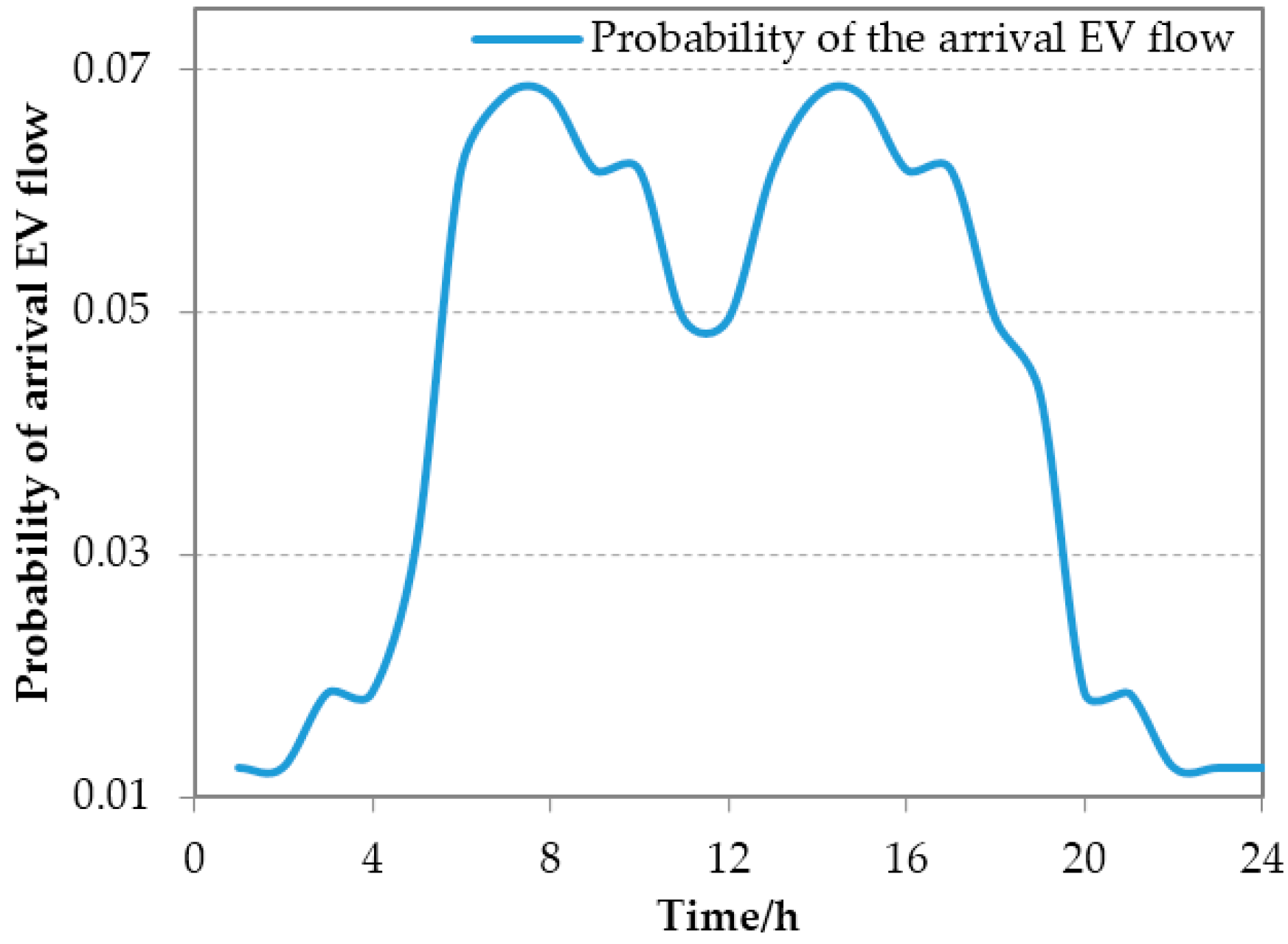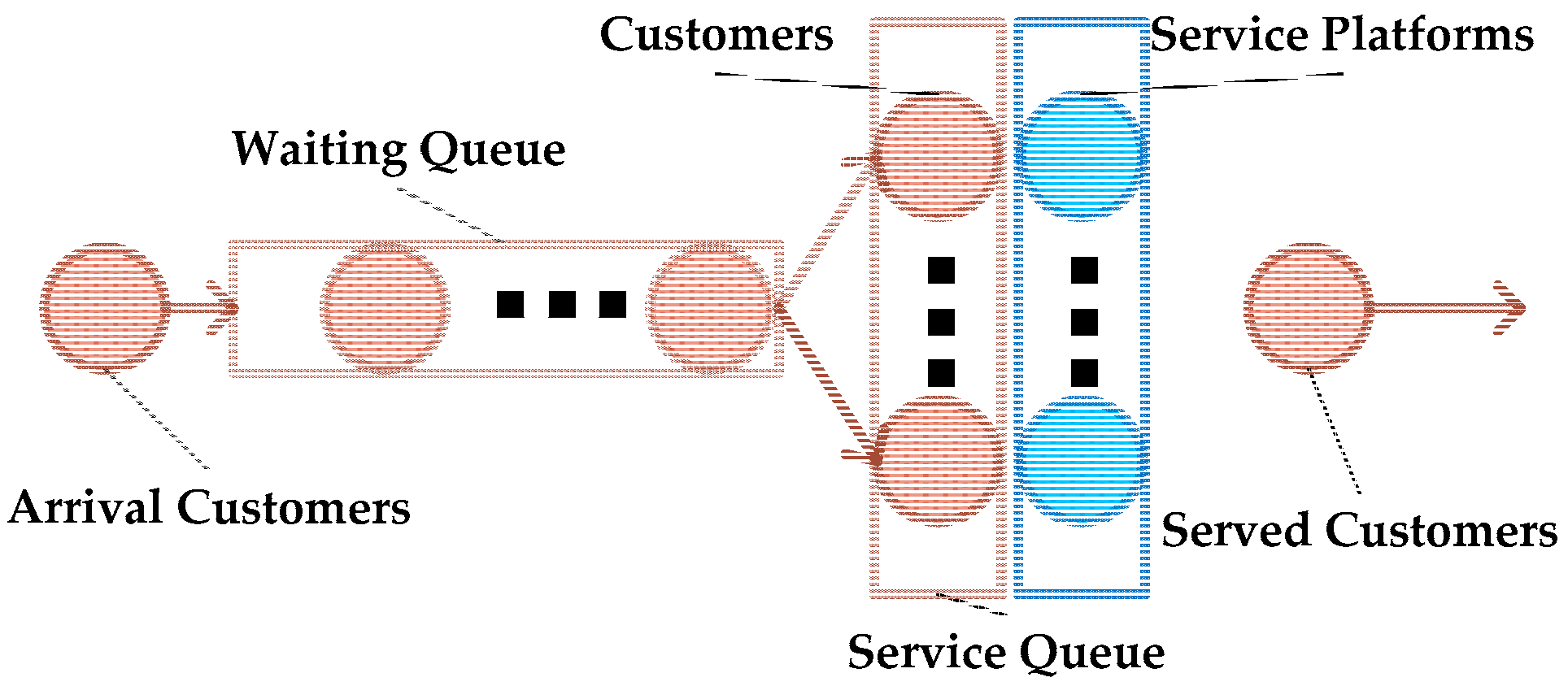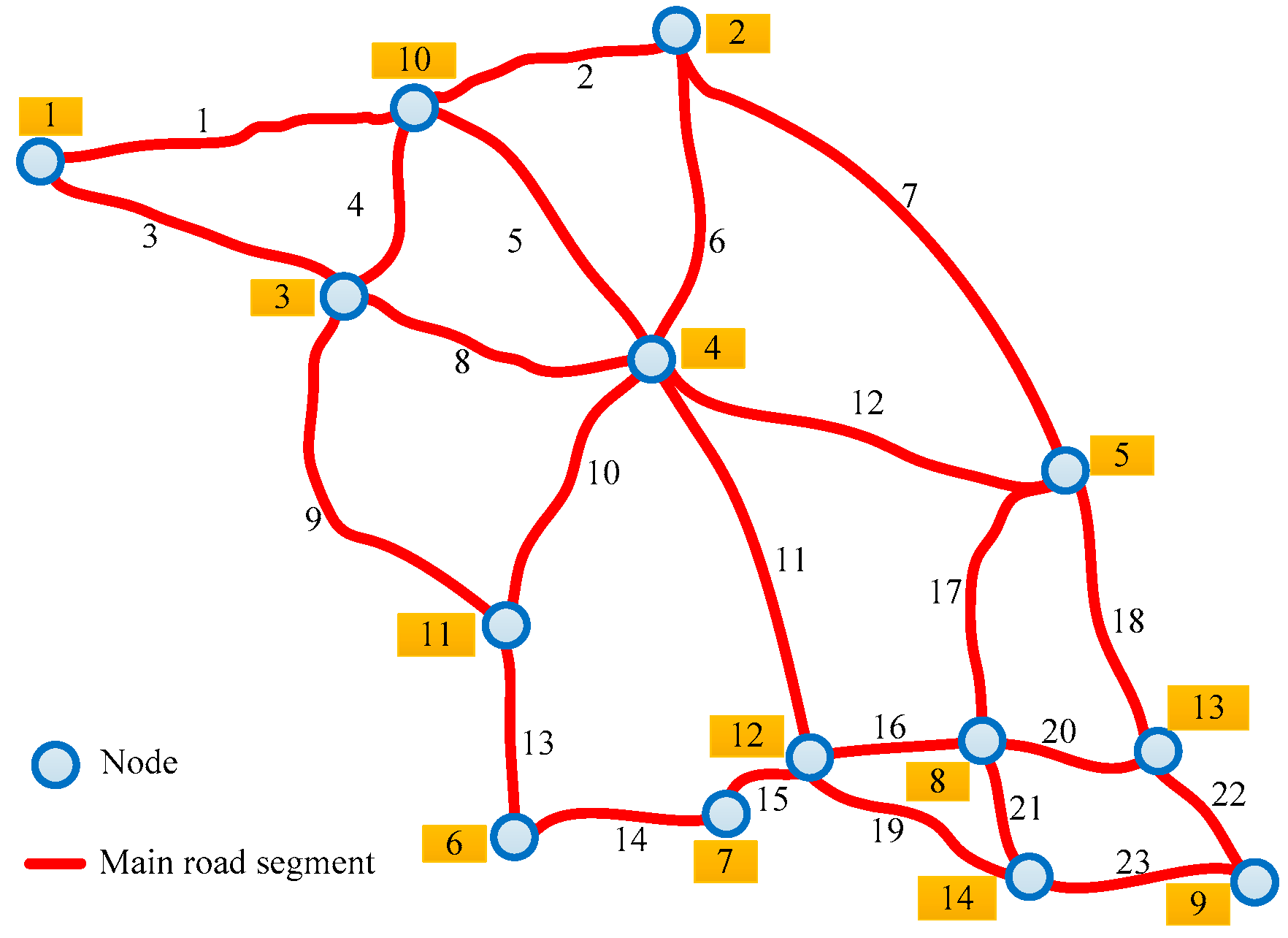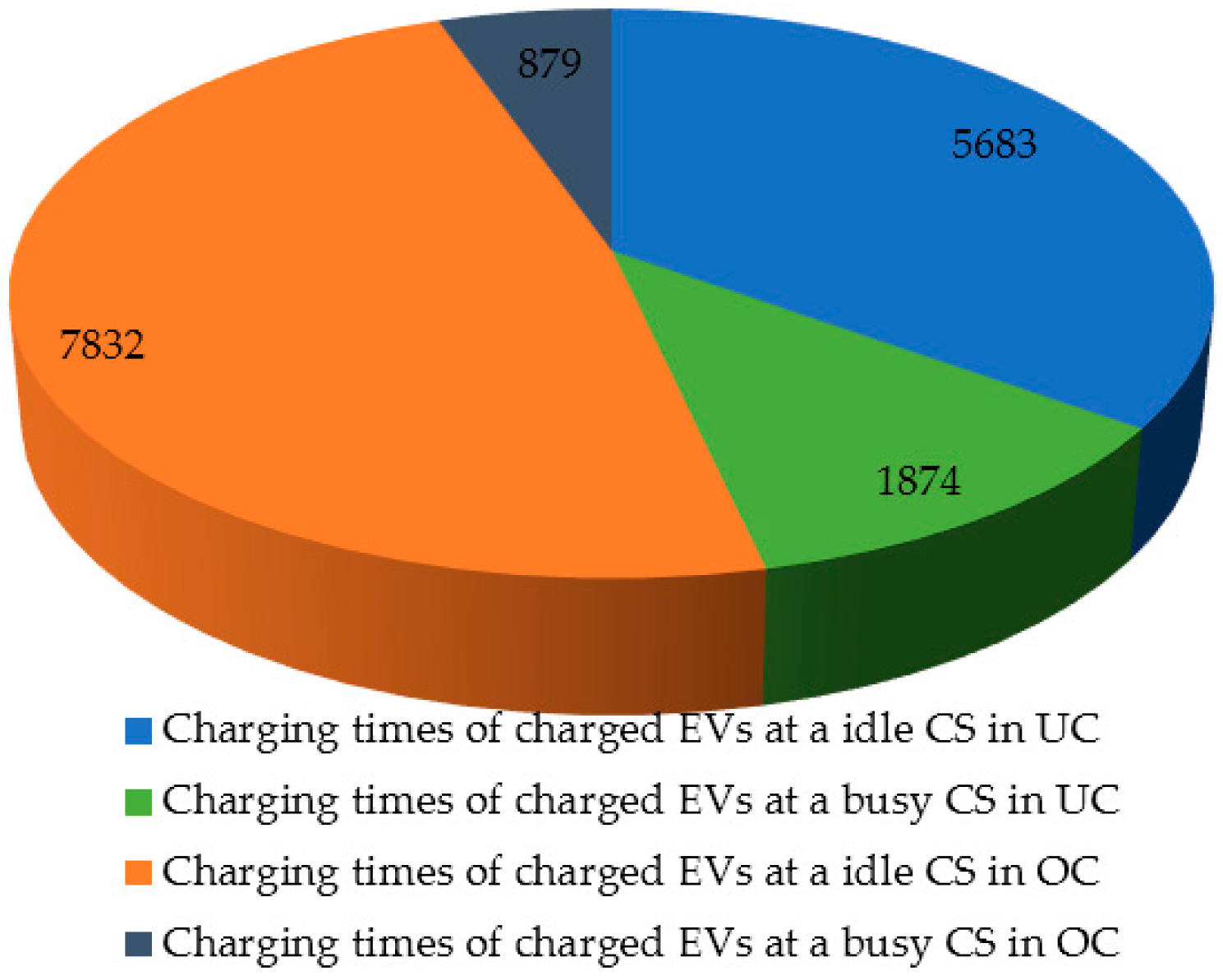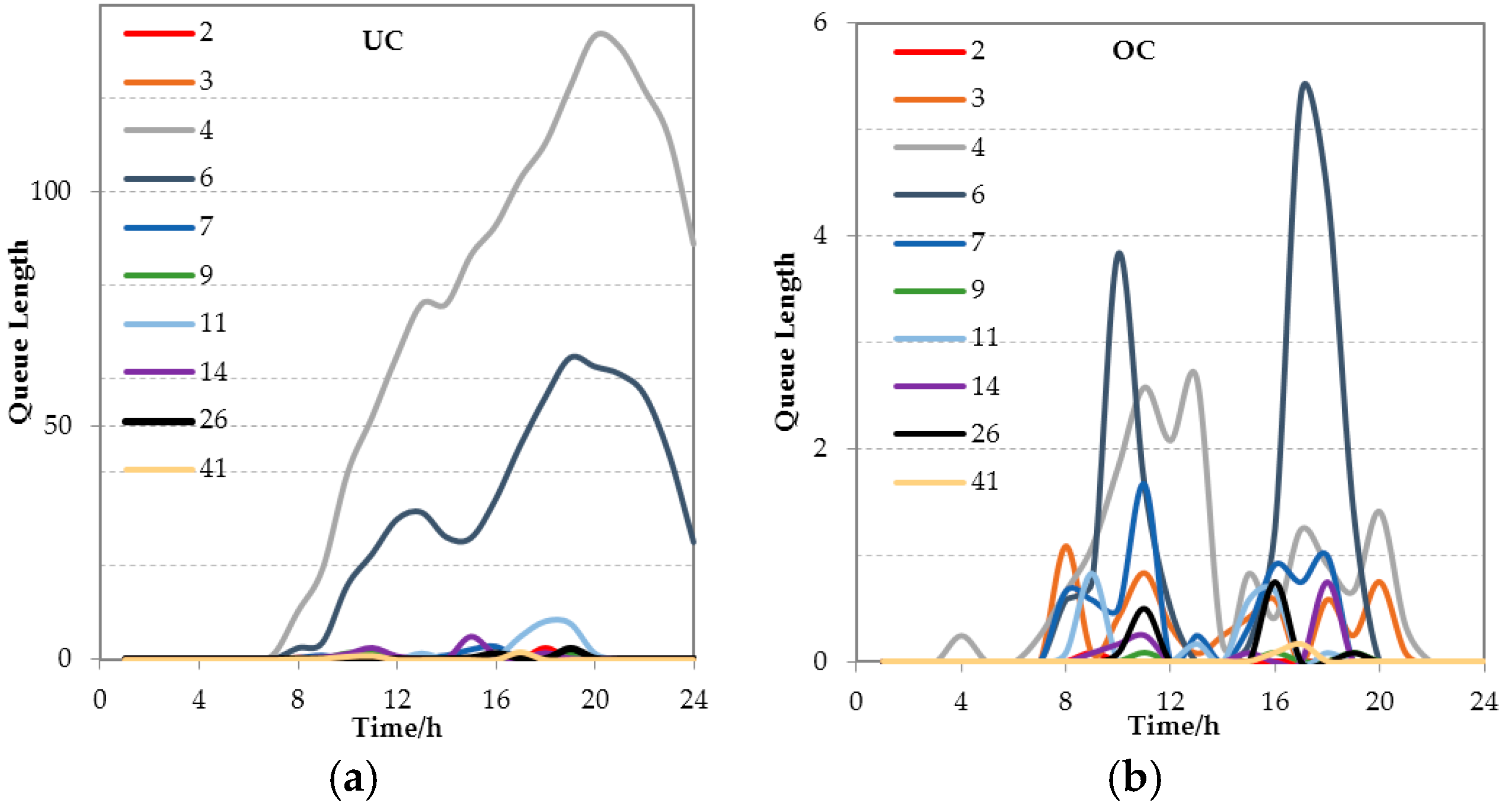1. Introduction
The world energy crisis, global warming, and environmental pollution have become focused problems to which people must find effective solutions. The development and use of electric vehicles (EVs) are widely considered as one of the solutions for energy-saving and emission-reduction in the world [
1,
2,
3]. With the large-scale adoption of EVs on expressways, building fast-charging stations (CSs) (with CS planning technology [
4]) will be necessary for people to drive the cars for a long distance. Fast-charging technology is increasingly being developed and improved. Battery-assisted charging system has been developed to improve the fast charging performance [
5]. However, low efficiency of fast-charging is a key issue affecting EV adoption [
6] (e.g., the Model S is the only EV able to charge at up to 120 kW at present, which corresponds to 273 kilometers of range in about 30 min, and the charging rate is about one-tenth of the refueling rate [
7]). Even if there is a great breakthrough in charging technology in the future, the efficiency of fast-charging will be difficult to achieve the goal of high efficiency just like refueling.
On expressways, EVs charging and CSs operation influence each other. If EVs are charged without guidance, some impacts on EVs themselves, CSs, power grid, and expressway network will appear as follows: EVs may be concentrated in a few CSs, thus resulting in congestion in the stations, and on the other hand, some other CSs may have no car to serve; this condition would result in the waste of charging facilities, fluctuations in electric load of each CS, overlong waiting time for EVs to get recharged, and overlong queues in CSs, and these problems would further influence the surrounding traffic and other users’ traveling and end up in a vicious circle. Therefore, guiding-based charging is urgently needed to effectively adjust interactions between EVs and CSs. Research shows that guiding-based charging can lessen the impacts of EVs and CSs [
8] (e.g., reduce the waiting time for EVs and workloads for CSs,
etc.); nevertheless, guiding-based charging should still be further explored for different requirements.
Guided charging is divided into reservation guided charging (RGC) and electricity price guided charging (EPGC). RGC can be divided into active and passive RGC. Active RGC means the user positively chooses a CS to make a reservation for charging, while passive RGC means the user interacts with the platform which will then specify a CS for the user. Current research on RGC mainly focuses on passive RGC and the ordered reservation algorithm (e.g., optimum matching algorithm [
8], artificial intelligence optimization algorithm [
9], optimal path algorithm [
10], and global information algorithm [
11],
etc.) employed by service plat forms to specify CSs for the users. Passive RGC lays more emphasis on how to offer suitable charging options for EV users, without considering either the impact of electricity prices on the user’s choice or management of the user’s charging process. EPGC is also divided into active and passive EPGC. Active EPGC means the user actively manages the EV charging process under the guidance of electricity price (e.g., independently choose or set the charging process), while passive EPGC means the user’s charging process is under control under the guidance of electricity price. Thus, it is similar with RGC in that positive EPGC also involves user choice, but it differs from RGC in that passive EPGC focuses more on effective management of the user’s charging process. The premise of passive RGC is that some of the vehicles with reservations for charging must have multiple charging options so as to conduct overall management of charging options of all vehicles with reservations based on adjustability of these vehicles. Therefore, RGC is suitable for CS intensive places. However, in the case of highways, given the long-established habit of refueling only when fuel vehicles are about to run out of fuel, EV users probably will charge their vehicles when the battery level reaches the alarm line. Additionally, CSs are sparsely distributed along highways (one CS every 50 km on average [
12]). Therefore, RGC cannot meet EV users’ requirements for CSs on the highway.
Current research mainly focuses on the passive EPGC in the open electricity market. The charging start time for EV clusters in the parking lot was optimized in [
13] to reduce charging costs for the users and achieve the objective of power grid peak load shifting. Partition optimization of charging power for EV clusters was conducted in [
14] to track photovoltaic power generation, stabilize charging load fluctuation, and reduce charging costs for the users and maximum new energy consumption. Hernández-Arauzo
et al. [
15] proposed the efficient algorithm for making charging schedules for the users, in order to maintain three-phase line balance and make maximum use of distributable power. Crow [
16] made an analysis of the optimum number of levels and price-duration of peak-valley time-of-use (TOU) prices for a given consumer demographic
versus utility generation mix, which can incentivize customers to better manage their energy use. Deilami
et al. [
17] presented a real-time load intelligent management algorithm coordinating charging behavior of multiple EVs, to improve security and reliability of the power grid. Research on large-scale EV scattered charging control was conducted and the price based distributed pricing mechanism is proposed and analyzed with a game approach in [
18]. However, EVs on highways mainly run in the daytime and passive EPGC does not involve user choice of CS, mainly focusing on management of the EV charging process. Hence, it can neither meet EV users’ requirements for CSs on the highway.
There are different requirements for EV charging and charging network operation on highways. EVs having charging needs always want to get charged at CSs without having to wait in a queue. CSs with EVs queuing up for charging wish there were no more vehicles to enter the station for charging to ease their operation burden, while CSs with no vehicles waiting for charging hope for vehicles to come to improve utilization of their charging facilities. However, these needs cannot always be well satisfied. In fact, EVs on highways do not necessarily start considering charging when the battery level reaches the alarm level and they can increase charging options through charging in advance. When EV charging is adjustable, users can decide whether to charge their vehicles based on whether a CS is busy or not, thereby adjusting the interaction between EVs and the charging network. To effectively accommodate this effect, it requires the addition of more vehicles with flexible charging options.
With this as the cutting point, this paper introduces a new electricity price form—status-of-use (SOU) price only related to the free/busy status of a CS (
i.e., electricity price is high during busy hours and low during idle hours of the CS and the electricity prices during busy and idle hours are fixed) based on the operation characteristics of CSs and the users’ response to electricity price for charging. This customized electricity price should take into account interests of both EV users and CSs and it can be formulated based on pricing strategies of the electricity market [
19]. Electricity price of an EV only depends on status of the CS when it enters into it, under no influence from vehicles following it. Hence, SOU pricing can satisfy requirements for CS operation and EV charging on highways, and is also easy to implement. For CSs, when busy hours start, they can restrain the entry of following vehicles by raising the electricity price to reduce workload of the CS, and during idle hours they can attract subsequent vehicles to come for charging by lowering the electricity price, thus improving utilization of charging facilities of the CS. For EVs, users with charging needs can charge their vehicles in advance (to increase charging options) at CSs that are not busy and actively choose the CSs for charging, thus achieving the least charging costs and waiting costs. The EV charging options can also improve operating efficiency of CSs and improvement in operating efficiency of CSs is, in turn, beneficial for EVs.
Therefore, this article proposes a SOU price-based charging strategy that can motivate users to charge in advance. The proposed charging strategy in this paper is also called an orderly charging (OC) strategy. The main contributions of this paper can be summarized as follows:
An OC strategy that can motivate users to charge in advance is proposed to guarantee the coordinated interactions between EVs and CSs and meet their own demands effectively;
A solution for analysis and verification of the OC strategy is proposed, including an established queuing model for a CS cluster and a queuing algorithm.
2. Strategy of Orderly Charging with a New Electricity Pricing Scheme
In the case of unordered charging (UC), a greater part of EV users, say 90%, would not recharge their cars until the battery level reduces to the warning value, due to the habit developed from their long-term use of fuel cars. On this occasion, the users have to charge their cars whether the CSs they are heading for are idle or not, or else the EVs would get stuck midway once the battery runs out. Thus, they have to conduct the forced charging action (FCA), which may lead to a lot of EVs entering a certain CS simultaneously and result in long waiting time for the cars as well as congestion in the station. Thus, EVs in FCA help little in adjusting the running state of CSs.
To effectively adjust interactions between EVs and CSs, it is necessary to guide EVs’ charging in advance by some practically effective economic or technical measures, which constitute the OC strategy in this paper. In the case of OC, on the assumption that 90% of EVs have battery level above the warning value and can make it to the next CS at least, the users can choose to get charged at the next CS to ease the burden of the current station if it is too busy. Since the charging activities of these users are somewhat adjustable and can be regarded as adjustable charging action (ACA), these users could be considered as the main objects to guide. This paper introduces a SOU price that is suitable for charging EVs on expressways after considering CSs’ running states, as shown in
Table 1 (this paper sets α and β to 0.15 and 0.11 based on [
20]).
It can be seen from the characteristics of users’ automatic response to the price incentive [
21] that the new charging price succeeded in motivating users to turn to idle CSs to get charged to some extent. In addition, this pricing scheme guarantees users to enjoy the electricity price agreed before charging during the entire charging period. Since every EV user can perform either FCA or ACA, the new charging price scheme is fair to all EV users.
 ” in Figure 5) were selected as O or D nodes in this paper. According to the prediction based on the statistics of traffic flow in normal expressway networks and the permeability of EVs [29], we assume the traffic flow of EVs on expressways per day is 12,000. The OD distribution of EVs between the OD of the expressway network is shown in Table 2.
” in Figure 5) were selected as O or D nodes in this paper. According to the prediction based on the statistics of traffic flow in normal expressway networks and the permeability of EVs [29], we assume the traffic flow of EVs on expressways per day is 12,000. The OD distribution of EVs between the OD of the expressway network is shown in Table 2.